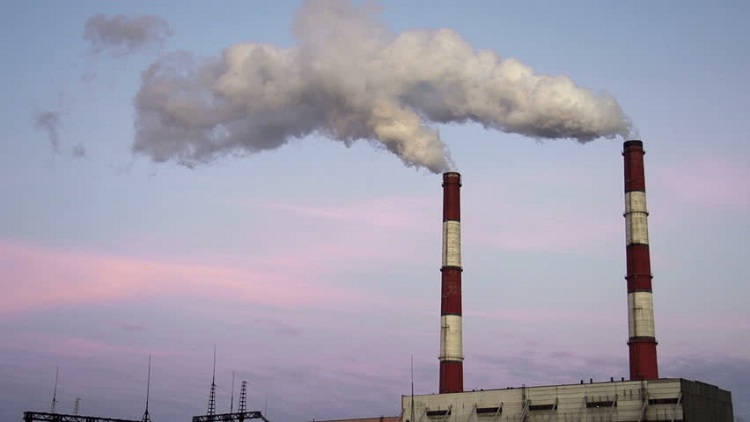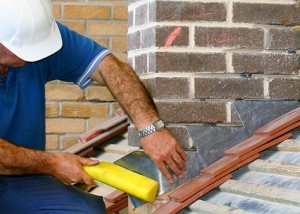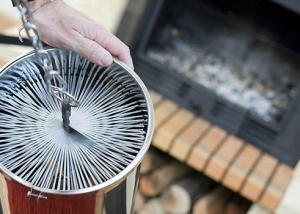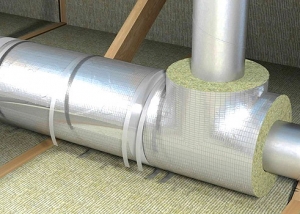The draft of the chimney is an aerodynamic phenomenon, which is caused by the movement of air masses from a point with increased pressure to a point of reduced pressure. This indicator is very important, as it ensures the normal exhaustion of the combustion products of the heater through the smoke outlet channel. In the event of a malfunction of the chimney structure for one reason or another, back draft occurs, which leads to smoke in the living quarters.
Content
Reasons for reverse thrust
Back draft in a chimney is a phenomenon that occurs as a result of a violation of the natural air circulation in the chimney communication. It is worth noting that in the event of this phenomenon, the normal operation of the chimney is disrupted, and it ceases to fulfill its main function - the removal of smoke outside the building.
Important! Normal rates of natural draft in a chimney range vary from 10 to 20 Pa. If there is a decrease in draft below 10 Pa, then in this case the removal of the products of combustion of fuel outside the house is violated, and they can get into residential premises.
Reverse thrust can occur due to various reasons. Consider these reasons:
- errors in calculating the height of the chimney channel (understated design);
- errors in the calculation of the chimney cross section indicator;
- a sharp change in weather (rain, fog, strong wind, etc.);
- narrow turns of smoke in the chimney design. This phenomenon causes smoke retention inside the residential building. Such turbulence occurs in the case of improper installation of the chimney pipe in relation to the roof ridge, namely, below the ridge. With this arrangement of the pipe, a “tipping” of the thrust occurs due to wind;
- a building located above the level of a concrete house with a chimney, located in the immediate vicinity of it. In this case, as a rule, there is resistance to draft in chimney communication;
- lack of air flow;
- problems with the internal ventilation system.
How to calculate the draft in the chimney?
Chimney draft calculation is an activity that is usually performed for industrial chimney structures. Such designs require fairly complex thrust calculations. For private homes, this indicator is less important.
Ventilation communications and chimneys have one principle that underlies their functioning. This principle is the difference in pressure between the inside and outside of the building. In order to calculate the necessary indicator of natural draft for a particular case, there is a rather simple formula: the height of the chimney must be multiplied by the difference in density of the external and internal air.
Consider the process of calculating draft in a chimney design in more detail:
- During the use of heating equipment, natural traction allows you to get rid of the products of combustion of fuel, removing them outside the structure.The difference in temperature indicates the difference in air density outside and inside the building. It is worth noting that for calculating the thrust you do not need to take into account such an indicator as dynamic pressure. This is not necessary due to the low speed of movement of air masses. The necessary data for obtaining natural thrust in a particular case are required to be substituted into the Bernoulli law formula for gas.
- The next step is to calculate the total pressure loss and compare these indicators directly with the thrust. The thrust calculation can be considered ready in the case when the pressure indicators are identical to the thrust value. Such a chimney design will perfectly cope with the tasks assigned to it and will last a fairly long operational period. However, if the identity could not be achieved, it is necessary to repeat the calculations again, changing the number of pressure losses or the magnitude of the thrust.
Helpful information! When installing ventilation communication, which also functions due to natural draft, the same calculations can be used.
To increase traction in the calculations, there are two main ways. Consider them:
- lengthen the chimney;
- increase the temperature difference, which accordingly reflect on the external and internal air density. It is worth noting that this method is not always possible.
In turn, the reduction in pressure loss is carried out by the following methods:
- increasing the cross section of the chimney duct;
- reducing the length of the smoke path through the channel (shortening the chimney);
- in addition, pressure losses decrease in direct proportion to the decrease in the roughness coefficient of the inner walls of the chimney;
- reduction in the length of horizontal sections that resist during the removal of combustion products of a heating device.
How to strengthen the draft in the chimney with your own hands?
Many owners of private houses equipped with chimney communication are interested in the answer to the question: how to increase draft in the chimney? As mentioned above, for the normal operation of this system, it is necessary that the pressure indicator of the ascending air be from 10 to 20 Pa.

To increase traction, you can use different methods, including the installation of such a device as a deflector
To determine the thrust index, you can also use special measuring instruments that can fix this indicator - anemometers. The decision to increase or, conversely, reduce traction depends on the readings of the anemometer. It is also worth noting that this also takes into account one more point - the results of the burning of fuel raw materials in the heating device.
Strengthen the draft in the smoke exhaust structure in several ways. Consider these methods:
- extension of chimney communication;
- deflectors;
- weather vane;
- rotary turbines;
- Electric smoke exhausters.
Note! Often, to enhance traction, you just need to clean the flue duct.
In addition, there are other methods that can cope with this common problem. It is recommended that you familiarize yourself with all options for dealing with low draft in a chimney system.
Chimney extension
This method of traction reinforcement is considered to be the simplest, since for its implementation it is only necessary to mount the chimney longer than was originally planned. Due to the difference between the boiler and the chimney outlet on the roof, the difference in the pressure indicators of the rising air flow also increases.
It is worth noting that the optimum height for a chimney construction is no more than 5–6 m (if the minimum distance between the chimney section lying in the vertical plane and the heating device is observed). It is also worth noting that this option of enhancing the draft index in the chimney is suitable only if the communication is mounted without knees, contractions and other areas that can act as obstacles to the removal of combustion products.
High roof contributes to the deterioration of smoke from the chimney structure. In addition, the location of a taller building in the immediate vicinity of the house in which the chimney is installed negatively affects the removal of combustion products. The lengthening of the chimney communication in this case is the surest solution of all.
But do not forget that excessive elongation of this structure greatly enhances the natural traction, and this leads to heat dissipation outside the residential building. In this situation, experts recommend the use of special dampers that reduce the amount of smoke emitted.
Baffles
The deflector is a device that allows you to stabilize the air flow that occurs in the smoke exhaust communication. The name of this product is translated as a guiding device and is fully consistent with its operational features.
One important pattern should be noted: the simpler this device, from a structural point of view, the more efficient it is in operation. This is due to the fact that the air masses redirected from the roof surface, together with the lateral air flows, contribute to the removal of smoke from the pipe.
Experts recommend the use of this device in windy regions, as in calm it is not effective. When choosing this device, you need to pay attention to two main factors. Consider them:
- the size of the chimney on the roof;
- wind load for a specific case.
In addition, it is worth saying that such a device can be performed without much difficulty and with your own hands. To do this, you need the following materials and tools:
- square;
- yardstick;
- scissors for cutting metal;
- ordinary hammer;
- riveter;
- manual type electric drill;
- set of drills;
- drill end screws equipped with a press washer, which has a size of 15 mm;
- sheet of tin or galvanized steel with a wall thickness of 0.3 to 0.5 mm;
- material for fasteners.
Before assembling such a traction amplifier for a chimney with your own hands, it is necessary to carry out calculations on paper and apply the necessary marking on the tin or galvanized sheet. The assembly diagram of this amplifier can be easily found on the Internet.
Next, proceed to the direct assembly of the amplifier for the chimney with your own hands. Consider the steps for assembling this device:
- First, it is necessary to cut out the details of the future deflector from tin or galvanized sheets (focusing on the marking).
- Then you need to roll the nozzle body and join the edges together with rivets or screws.
- At this stage, the two cones of the product are docked.
- The studs are mounted in the lower cone. This is necessary in order to dock the lower cone with the common body of the deflector.
- The lower cone is docked with the device body. It must be remembered that all the connections in the device must be organized firmly enough so that the deflector can withstand strong wind flows during operation.
Thus, it becomes clear how to make the draft in the chimneys with the help of a fly hanger with your own hands, however, there are still many devices and means that allow such an event to be performed.
Weathervane
The weather vane, like the deflector, enhances traction, depends on the strength of the air flow and has a very simple design. However, unlike the deflector, the weather vane does not prevent the removal of combustion products from the chimney in calm weather.
Note! From a structural point of view, the weather vane is a wing that is small in size and protects the chimney from the wind from one particular edge.
Such a device also has a special element called an auxiliary blade. The auxiliary blade is mounted opposite the location of the vane on the chimney.
The main function of the auxiliary blade is to protect the mouth of the chimney pipe from the air masses flowing around it and causing the occurrence of discharged zones. Due to such discharged zones, the draft in the chimney is greatly increased, which, accordingly, negatively affects the heating.
Experts recommend using a weather vane in cases where the draft indicators in the chimney are unstable, as well as in severe windy weather, which destabilizes the draft.
Rotary turbines
A rotational turbine is a mechanism that increases traction in chimney communication using wind power. The nozzle on such a turbine always rotates in only one direction, regardless of which side the wind blows. Due to this, the necessary vacuum appears over the chimney, which contributes to an increase in draft in the system.
Such a chimney draft amplifier has a design that not only contributes to the removal of combustion products from the chimney, but also prevents it from clogging with leaves, branches and other debris.
The main feature of such a device is that in calm weather it does not function, and during the non-heating season it helps to remove air from the chimney channel. In addition, in windy weather, such devices can increase traction due to the effect of vacuum.
It is categorically not recommended to mount rotary turbines in chimneys that discharge solid fuel combustion products. This is due to the fact that the operating temperature for such devices does not exceed 150–250 ° C.
Electric smoke exhausters
They are mounted on chimneys, which carry out the removal of combustion products from heating devices operating on solid fuel. The temperature of the working medium for electric smoke exhausters ranges from 650–800 ° C.
In addition, an important advantage of these electrical devices is that they are able to fully provide automation of the chimney design. As a rule, such devices are equipped with special sensors that regulate the intensity of the drive. Consider what sensors are equipped with electric smoke exhausters:
- sensors that monitor the temperature of the working environment;
- sensors that determine the strength of the air flow.
In addition to the above options, there are other ways to enhance natural draft in the chimney.
Other ways to increase chimney draft
Consider folk methods of increasing traction in smoke exhaust communication:
- chimney cleaning by means of a special metal ball, which is mounted on a cable;
Helpful information! Trash plugs in the chimney canal are punched quite simply: a ball mounted on a cable slowly lowers along the canal until 1-2 meters remain to the alleged obstacle.After that, it is necessary to quickly lower this ball to the mash, which will allow to break through it.
- ensuring the tightness of the chimney vulnerabilities (holes, cracks, etc.);
- cleaning the windshield from dirt or icing. In addition, it happens that the flyarocks fail, then it is necessary to take care of fixing it;
- ventilation of residential premises, which will create the necessary traction support;
- creating additional vacuum by preheating. To warm the communication, you can use several ordinary newspapers that need to be burned.
Any of the above devices or events can help in a particular situation. When organizing additional measures to enhance traction, it is recommended to be careful and comply with fire safety rules.













